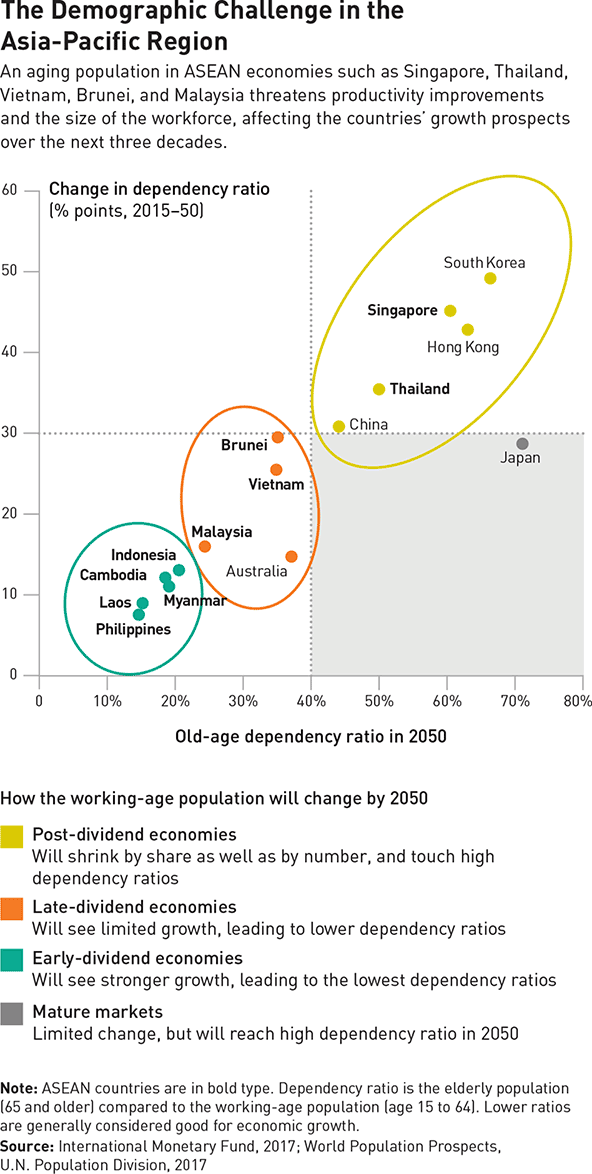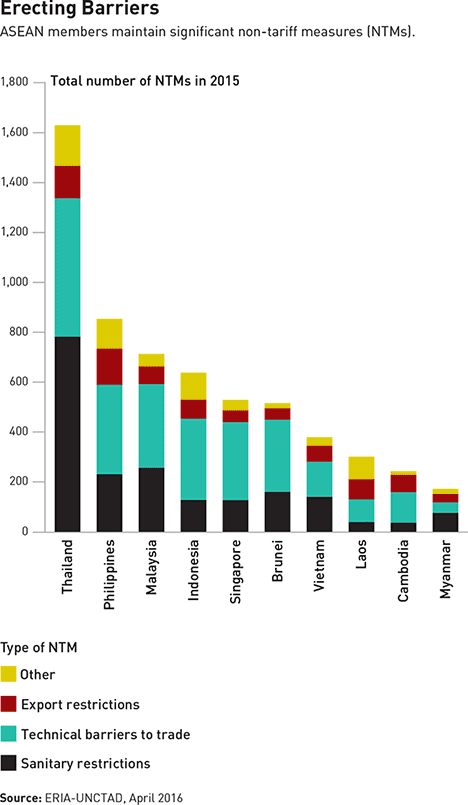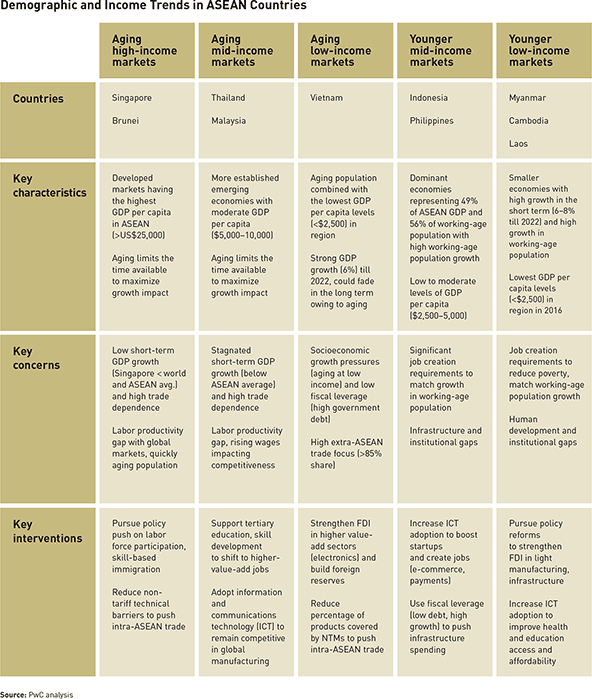Sustaining Southeast Asia’s momentum
How the 10 countries of the vibrant ASEAN region can avoid the threat of slower growth.
There can be few more eye-catching signs of the economic vibrancy of Southeast Asia than competition for ride-hailing services on the streets of its biggest cities.
In Jakarta, the bustling capital of Indonesia, it is hard to miss the green-helmeted motorbike taxi riders of Go-Jek, a homegrown company that has built a thriving ride-hailing business in only eight years. Go-Jek, which derives its name from ojek, an Indonesian word for motorbike taxi, launched its first overseas foray in September 2018 by entering Vietnam and tapping into the fast-growing ride-hailing scene in Ho Chi Minh City, Hanoi, and other cities. Next up are expansions into Thailand, the Philippines, and Singapore. Those moves will pit Go-Jek against the region’s biggest ride-hailing company, Singapore-based Grab, and competitors such as Ryde and MVL, sparking a battle for the region’s booming ride-sharing market.
It is a tussle involving considerable sums of money from some big investors. Grab, founded by a Malaysian businessman and operating in eight markets in Southeast Asia, raised US$2 billion in 2018 after a round of funding that attracted investment from Toyota and valued the company at $11 billion. Go-Jek, which already counts Chinese e-commerce giant Tencent and Singapore’s state investment company Temasek as investors, reportedly is in discussions to raise $2 billion to bolster its regional expansion plans.
Ride-sharing companies are just one example of the rampant commercial activity in Southeast Asia. The Association of Southeast Asian Nations (ASEAN), a 10-nation bloc founded in 1967, stretches from Myanmar in the west to the Philippines on its eastern flank. The other eight members are Brunei, Cambodia, Indonesia, Laos, Malaysia, Singapore, Thailand, and Vietnam. The grouping has a population of 630 million (30 percent larger than the combined population of the NAFTA countries), and its nations had a combined GDP of $2.76 trillion in 2017, which is larger than the GDP of India and makes ASEAN the fifth-largest economy in the world.
Its dynamism, its growing middle class, and the entrepreneurial flair of its businesses have made ASEAN one of the consistently best-performing regions in the world since the 2008 financial crisis. So it’s no surprise that a large number of investors and multinationals are turning their focus to ASEAN’s dynamic markets. The bloc’s economies are at vastly different stages of political and economic development — Singapore’s GDP per capita of $57,713 dwarfs that of Myanmar, at $1,278, as of 2017. But they all share immense growth potential. And aside from serving as a major global hub for manufacturing and trade, the bloc offers one of the fastest-growing consumer markets in the world. The region’s middle class is projected to rise to almost two-thirds of the overall population by 2030, compared with only 29 percent in 2010.
Having grown at a 4.8 percent rate for the last five years, ASEAN is projected to grow by 5.2 percent, on average, over the next five years, according to the OECD. Cambodia, Laos, Myanmar, and Vietnam are expected to record growth rates among the highest in the region, ranging between 6 and 7 percent, over the same period. Few regions of the world, or individual countries, can project such numbers. At the 50th meeting of ASEAN economic ministers in November 2018 in Singapore — which held the customary rotating chair of the bloc throughout that year — the city-state’s prime minister, Lee Hsien Loong, predicted that the grouping would be the world’s fourth-largest economy by 2030, behind only the U.S., China, and the European Union.
Much of the region’s strength can be attributed to a demographic dividend: Fully 60 percent of its vast population is under 35 years old. And as these young workers have entered the workforce in huge numbers, they have proved a valuable source of human capital and growing consumer power. Most of Go-Jek’s and Grab’s Indonesian motorbike drivers are under 35.
However, as other countries in the region have found, there is another side to the demographic story: an aging population. Vietnam is a case in point. The third most populous country in ASEAN, it is also one of the most rapidly aging countries in the world. In 2017, one in every nine people, or 11 percent of Vietnam’s population of 95 million, was age 60 or older. According to the government statistics office, that proportion will rise to about 20 percent by 2038. The International Monetary Fund forecasts that neighboring Thailand faces the likelihood that by 2050 its old-age dependency ratio (those 65 and older as a share of those between 15 and 64) will rise to more than 50 percent, up from 15 percent today — a development that will noticeably shrink the country’s working-age population. This structural shift points to an emerging drag on ASEAN’s growth prospects, because it spells a net decline in working-age populations in some of its leading economies (see “The Demographic Challenge in the Asia-Pacific Region”). In short, some countries have a limited demographic window available to maximize economic growth.
Indeed, the graying population provides but one argument for our contention: that the era of “passive” growth for ASEAN is over. Despite a growth story that has been largely unblemished since the Asian financial crisis of the late 1990s, a number of challenges have raised questions about the sustainability of the bloc’s growth trajectory over the next half century. These include external challenges such as a recent slowdown in short-term economic growth and the impact of Industry 4.0, as well as three major internal challenges: weak productivity, high external trade dependence, and huge infrastructure gaps.
But demographic trends are not necessarily destiny, and neither are the other structural challenges ASEAN faces. The region has a suite of advantages and resources it can deploy to power through the rising headwinds. And we believe that by confronting and addressing its challenges head-on, by taking active measures, the 10 members of ASEAN can show the world that the timely interventions that so often have eluded governments and regional groupings in the past not only are possible, but indeed can chart a new trajectory for sustainable prosperity.
ASEAN’s trajectory is also of high relevance to companies in the U.S., Europe, and other parts of Asia, such as Japan, because of the strategic importance of the bloc’s markets, shipping lanes, supply chains, and supply of industrial labor. The narrow Malacca Strait is the busiest shipping lane between the Indian Ocean and the Pacific Ocean. Thailand is the region’s hub for automotive production and is sometimes dubbed “the Detroit of the East” thanks to its highly developed automotive manufacturing ecosystem involving big OEMs such as General Motors and Nissan, as well as suppliers. Malaysia has a well-developed electronics cluster centered on the port city of Penang, with shipping and air freight connections globally. The Philippines has a thriving business process outsourcing sector that is used by many multinational companies, and Singapore is the region’s undisputed financial and commodities trading center; it also boasts the world’s largest bunkering (fuel storage) port. Collectively, the nations of ASEAN represent a vast market of mobile-savvy consumers, and e-commerce, digital payments, and fintech generally are booming.
Adapting is of particularly high relevance now, thanks to tectonic shifts underway in geopolitics and the evolving nature of global trading relationships. Demographic changes and the spread of globalization have served as twin engines propelling the region’s growth. And as the aging population saps one source of propulsion, uncertainties about the evolution of the global trading system could further weaken momentum. There is a risk that ASEAN’s core value proposition of lower labor costs could fade away over the coming decades as protectionist sentiment rises and new technologies improve the economics of retaining or re-shoring production within the borders of the developed parts of the world. “The political mood in many countries has shifted against free trade and, in particular, the recent trade tensions between the United States and China are worrying concerns,” Singapore’s prime minister Lee told the ASEAN summit at the end of 2018. “ASEAN countries will have to react to these major external trends.”
Internal Challenges
In an increasingly competitive global economy, stagnating productivity is becoming more of a concern — around the world and in ASEAN. Labor productivity has doubled across the bloc since 1990, but industry data indicates a wide gap between ASEAN and global markets at present. That highlights an opportunity for the bloc to improve through interventions such as investments in human capital, infrastructure development, institutional improvements, and digital technology adoption.
The International Labour Organization (ILO) found in 2017 that most countries in ASEAN, especially the emerging markets, recorded much lower output per worker than their global counterparts (see “The Labor Productivity Gap”). But Singapore, widely recognized for the economic miracle it has achieved since its creation as an independent city-state in 1965, recorded a mere 0.2 percent growth in labor productivity in 2015–16, a fraction of the more than 2 percent annual growth over 2000–10. Thailand and Malaysia scored comparatively poorly as well. These two maturing economies are also witnessing strong growth in wage levels — while already having some of the highest minimum wages in ASEAN. Although such wage growth bolsters consumer spending, it also increases the need to improve worker productivity to counter growing labor costs.
In fact, rising wage levels soon will dilute the low-cost advantage enjoyed by many emerging ASEAN markets over competitors in their hemisphere, and around the world. Some ASEAN countries are estimated to have recorded among the highest real wage increases worldwide in 2017, with Vietnam (7.2 percent), Thailand (5.6 percent), and Indonesia (4.9 percent) leading the trend. These figures are much higher than the global average of 2.3 percent. The misalignment of productivity and wage growth will gradually lead to diminishing economic competitiveness, greater unemployment, lower profit margins, and diminished investor confidence.
Coupled with an aging population, the pincers of weak productivity and strong wage growth will put further pressure on these economies to strengthen their institutions and capabilities, and thus strengthen their long-term economic prospects.
But for more immediate help, one place to look is digital technologies, which can significantly affect productivity. According to the most recent annual Global Connectivity Index released by Huawei Technologies, a single-point improvement in a nation’s digital connectivity score, which runs on a scale from 20 to 85, could lead to more than a 2 percent increase in productivity and national competitiveness. Developed ASEAN countries (Singapore, Brunei) in particular, having more advanced institutions and infrastructure (and hence limited scope for improvement on this front), as well as having aging populations, should focus on increasing their adoption of technology to counter declining productivity growth. ASEAN markets will need to prioritize productivity improvement measures to boost economic growth, or risk losing out to global competitors. In addition to making regulatory interventions, such as a reduction in non-tariff trade barriers, this will also require local governments and the private sector to invest in new digital technologies and infrastructure development.
The grouping also needs to figure out how to navigate technological disruption. Industry 4.0, which is bringing new technologies such as automation, augmented reality, cloud computing, and the Internet of Things (IoT) to bear on established processes and facilities, could produce much-needed benefits in the form of better jobs, greater connectivity, improved services such as healthcare and education, and more business and investment. However, as with any revolution, some people feel a negative impact in the short term. ASEAN could be such a potential victim of Industry 4.0. Take automation. We see a scenario in which multinational corporations re-shore some manufacturing to developed markets and adopt “4.0” technologies in those plants they keep in ASEAN — a scenario that would hit a less developed ASEAN member such as Cambodia or Myanmar particularly hard. In general, the results could lead to increased unemployment, a reduction in disposable incomes, and potential social unrest and economic contraction.
In an increasingly competitive global economy, stagnating productivity is becoming more of a concern — around the world, and in ASEAN.
In addition, technological disruption comes with its own set of challenges. For example, if robots become cheaper to employ than humans, will expanding manufacturing capacity still lead to job creation? In a 2016 report, the ILO found that around 56 percent of all employment in five key emerging ASEAN countries (Cambodia, Indonesia, the Philippines, Thailand, and Vietnam) faced “a high risk” of automation in the subsequent 20 years. Together, these five countries represent a vast majority (about 80 percent) of ASEAN’s workforce at present. Creating a vibrant and integrated innovation ecosystem to teach IT and technology skills is another issue ASEAN will have to deal with in order to minimize these potential job losses. Such an ecosystem will require closer collaboration among different stakeholders, including large multinationals, entrepreneurs, government agencies, and research institutions, to foster skills in new areas relevant to a digitized world, such as data sciences, digital user experience, human-centered design, and cybersecurity. Intra-regional cooperation will need to be enhanced. More advanced production hubs such as Singapore and Thailand will need to take the lead in testing new technologies, and in developing best practices to improve adoption across the rest of the region and among less productive segments such as small and medium-sized enterprises.
Balancing Trade
External trade dependence — the degree to which a region produces goods and services for countries outside the region — has been a persistent feature of ASEAN for many years. In particular, the bloc faces significant risks associated with its high level of dependence on the U.S. and on China, which together accounted for 26 percent of trade in goods as of 2017. ASEAN exports to China increased in value by an average of 10 percent annually over the past 10 years, reaching 17 percent of all ASEAN trade in goods in 2017. Any deepening of the current slowdown in the Chinese economy amid efforts to shift it to a more consumption-driven model could impact trade. The extent of these linkages can be judged by estimates released by Oxford Economics, which suggest that a drop of one percentage point in China’s GDP growth in the future could reduce ASEAN exports by 0.3 to 0.6 percent. Moreover, global trade growth is also slowing down, with the WTO downgrading its outlook for 2018 and 2019, citing significant downside risks to its growth projections.
At the same time, intra-ASEAN trade — i.e., commerce between member states — although it has risen in value, from $164 billion in 2005 to $311 billion in 2017, has remained stagnant over the past decade at around 25 percent of all exports. By contrast, intra–European Union (E.U.) trade represented 64 percent of overall E.U. exports in 2017. To a large degree, production in ASEAN consists of so-called intermediate goods, such as electronic components that are part of global supply chains and thus destined for end markets where the goods are either assembled or consumed.
Ominously, protectionist sentiment is rising around the world. This has been expressed most vividly in the region by the withdrawal of the U.S. from the Trans-Pacific Partnership (TPP) in 2017 and could further threaten ASEAN’s trade growth. It is therefore important for the group to take active measures to increase intra-regional trade flows — to not only serve the fast-growing domestic consumer base, but also counterbalance these additional risks. A key measure needed to help boost intraregional trade is the strengthening of regional cooperation, especially through the reduction of non-tariff trade barriers. Mahathir Mohamad, Malaysia’s 93-year-old prime minister, told policymakers and business leaders at the 2018 Singapore summit that pushing the 25 percent share up to 30 percent might seem ambitious but was possible given the grouping’s strength in numbers. “This is not the time to close our doors by invoking trade protectionism measures, but instead we should be actively engaging in finding amicable solutions and resolving trade issues through multilateral dialogues such as between ASEAN countries,” the prime minister said.
The good news is that 96 percent of tariff lines and 70 percent of intra-ASEAN trade flows are currently tariff free. But customs and levies aren’t the only factors that inhibit trade. The elephant in the room in this context is the many non-tariff barriers in the region — the result of the steady implementation by ASEAN member-states of non-tariff measures (NTMs). There has been a consistent rise in the number of NTMs, which are often aimed at bolstering domestic companies and industries, and which have stifled intraregional activity (see “Erecting Barriers”). This mix of import- and export-related policies has grown substantially, from 1,634 measures in the year 2000 to a high of 5,975 measures in 2015 across ASEAN. In terms of the type of NTMs, 43 percent are import restrictions related to technical product requirements; 33 percent take the form of sanitary measures related to public health and safety; and 13 percent are export-related restrictions. As an example of an NTM in ASEAN, a company certified to sell halal food products in Malaysia needs to undergo recertification to export to Indonesia, to adhere to the Indonesian industry’s halal standard — which has significant time and cost implications for the exporter. Similarly, the Thai government imposes stringent licensing requirements for the import of raw materials, petroleum, industrial machinery, textiles, pharmaceuticals, and agricultural items.
Infrastructure Gaps
Patchy infrastructure is a third significant challenge. Although the stage of development varies significantly from country to country, it is clear that across ASEAN, people’s daily experience is too often one of clogged roads, inadequate bridges, and regular power outages. As in other developing parts of the world, infrastructure limitations continue to slow the pace of growth. Significant gaps exist across a range of sectors: for example, utilities, transportation and logistics, and digital connectivity. As of mid-2018, only 20 percent of roads in Myanmar were paved, and only 53 percent of Cambodian households had access to grid-quality electricity. The Indonesian national development planning agency estimates that a lack of adequate transportation infrastructure and the resultant traffic congestion accounts for more than $4 billion in annual losses to the city of Jakarta in the form of fuel wastage, productivity losses, and health impact on its residents. Total infrastructure investment needs in ASEAN from 2016 to 2030 are estimated by the Asian Development Bank (ADB) to be around $2.8 trillion, indicating an annual investment requirement of $184 billion — equivalent to 7 percent of the bloc’s gross domestic product in 2017.
In addition to reducing the productive capacity of the workforce, these gaps increase the cost of doing business for companies, hindering national competitiveness while limiting market access and social well-being. For example, logistics costs in 2016 represented about 9 percent of gross domestic product in Germany and 12 percent in Brazil. In Vietnam the figure was 21 percent, whereas in Indonesia — ASEAN’s largest economy and most populous nation — it was as high as 26 percent.
Yet enhancing the scale and quality of infrastructure could have a significant economic impact on these countries, especially in helping to manage looming issues related to productivity and job creation. For example, estimates by the ADB indicate that a 10 percent increase in paved road density could result in a 1 percent increase in trade and a 5 percent improvement in economic growth across Asia.
Finally, a significant gap exists in terms of what we might call institutional maturity. As is the case in most emerging economies, the business environment in ASEAN is still maturing and is marked by institutional gaps that weaken international investor confidence and the region’s growth, more so during periods of global uncertainty. Corruption, in particular, features as a major concern for businesses operating in the region. In the ASEAN Business Outlook Survey 2017, conducted by the U.S. Chamber of Commerce, 65 percent of respondents cited what they saw as unfair and inefficient law enforcement practices as a major challenge in the region — with the exception of Singapore and Brunei. Those operating in the Mekong region said they faced stronger pressures to pay bribes in order to obtain essential permits and government services. Besides corruption, lack of regulatory clarity continues to impede growth. A significant percentage of businesses (42 percent) indicated that consultations between the government and the private sector were limited while new laws and regulations were being developed.
A Path Forward
The scale of challenges ASEAN faces is immense, and seemingly daunting. But the region has substantial resources at its disposal. And we believe that three sets of active measures will allow the region to continue to make progress through the headwinds it faces.
The first involves renewed efforts by the ASEAN secretariat, which was set up in 1976 to coordinate the bloc’s initiatives and provide governance and implementation help for policies. A key priority for the Jakarta-based body should be facilitating internal trade, in particular fostering the harmonization of multiple non-trade barriers to create a more fluid internal economy within ASEAN. A boost to the secretariat’s budget and staff would be helpful, too.
The second set of measures would be for member countries to tackle, head-on, their shared demographic challenges in productivity and aging populations. Given that countries are at different stages of development and face different degrees of demographic challenge, these measures should include short-term policy interventions such as addressing talent gaps through encouraging inward migration, and long-term reforms targeted at improving the labor force participation of women and older people. For example, in fast-aging markets such as Singapore and Thailand, only 60 percent of women participated in the workforce in 2017, compared with 77 percent of men. Specific interventions will also need to target a range of other levers, including human capital, trade, technology, and investments, which will vary by market in ASEAN (see “Demographic and Income Trends in ASEAN Countries”).
The third set of measures revolves around the private sector, which will have a major role to play in making these interventions in ASEAN, and thus in strengthening the region’s growth prospects over the coming years. Companies will need not only to provide new products and services to meet varying consumer preferences, but also to work more closely with governments to develop the right conditions for businesses to prosper. The principal measures the private sector should pursue are described below.
Develop more localized business models. Conduct more research and development locally, bringing about a transition to more localized sourcing, production, and sales through the development of regional hubs to serve ASEAN consumers. For example, automakers looking to establish a bigger foothold in the region can increase localization more holistically — in sourcing, manufacturing, sales, and research and development. Doing so will allow them to offer greater competitiveness, more localized products, and greater differentiation. This strategy could be adopted in phases as companies gain further appreciation of local markets, shifting from a production model based on semi-knocked-down assembly (in which factories receive partially assembled parts) to one based on assembling completely knocked-down kits (in which factories receive unassembled parts) and then finally to full-scale production. Automakers can progress to the final stage of full-scale production as they establish more reliable, long-term production volumes, aiming to achieve local sourcing of 70 percent or more to fully leverage tax incentives in the region. It will also be important to work with government and associations to ensure that the right level of skilled workers are coming into the market.
Healthcare offers a particularly compelling opportunity for developing localized business models. Government and healthcare leaders are aware that this region is at a critical point, with its aging population. Chronic diseases such as diabetes will need to be tackled with appropriate care at an affordable price. Medical device companies have an important job in ASEAN: to improve the access, affordability, and quality of healthcare. But rather than simply import expensive devices from the U.S. and Europe, medical device companies might borrow a page from China’s or India’s playbook, and seek to build customized and affordable devices for the market, using local and regional business models to meet patients’ needs. For example, GE Healthcare found that its premium-priced ultrasound scanners were unaffordable for 90 percent of hospitals in China. Through local R&D, sales, and marketing, GE Healthcare’s China team developed a handheld ultrasound scanner at 15 percent of the original cost. This product is now being used even in developed markets, as a portable scanner in ambulances and operating rooms.
To further improve affordability, companies can also offer financing alternatives to local hospitals such as leasing and contracting of medical equipment, supplemented with a regular program of upgrading and maintaining the equipment.
Embrace a holistic digital operating model. The adoption of digital capabilities can improve the production and transportation of goods and services, as well as communication with consumers and businesses. With expectations of mass customization being brought about by Industry 4.0, a unified ASEAN market promises the formation of a truly massive consumer base that could push growth in local production to meet its requirements for more personalized products coupled with quicker order fulfillment in segments such as footwear, accessories, and consumer electronics. Companies have a significant opportunity to grow across ASEAN by leveraging digital capabilities not only to connect directly with consumers to inform and influence purchasing habits, but also to employ greater efficiencies throughout their supply chain, using platforms such as IoT or blockchain to track and trace assets (products, people, equipment) across the value chain, or to improve access to trade finance for smaller enterprises. Furthermore, warehouses — which are currently labor- and paper-intensive — are ripe for conversion to automated systems, providing better visibility on inventory.
“Technological change brings exciting solutions to persistent problems, yet is disrupting jobs and economic development pathways,” Justin Wood, head of the regional agenda for Asia-Pacific and member of the executive committee at the World Economic Forum, points out. “The countries of ASEAN have every chance of harnessing these disruptions for their benefit, but success will require a new approach to policymaking and new commitment to regional cooperation.”
Use partnerships and integration models. Developing partnerships and alliances that cross sectors and involve industry disruptors will be crucial as companies try to stay relevant and competitive while meeting consumers’ expectations profitably. New business models, such as platform sharing (for example, for automotive production) or vertical integration (such as fuel refining with petrochemicals), are other strategies relevant to addressing the increasing cost of production in ASEAN. Platform sharing enables cost savings from the use of similar components and more efficient inventory management, and allows automakers to redirect spending to other areas such as adapting models to regional consumers or improving product design. Similarly, integrating refining units with petrochemical facilities could enhance operational efficiencies through greater synergy and flexibility in operations, resulting in much stronger margins. An integrated complex with crude processing capacity of around 200,000 barrels per stream day could generate gross margins of approximately $9 to $15 per barrel, depending on market conditions and operational factors, as compared with only $3 to $6 per barrel for a stand-alone refinery.
Governments in the region see these challenges through a domestic lens, which is understandable given the developing economic maturity of most of its member nations. Yet we think they should recognize the value of regional integration and cooperation, and take action to strengthen the position of ASEAN on a number of fronts so that it can maintain its reputation as the world’s most compelling growth story. Annual GDP growth in leading ASEAN economies (both emerging and developed) has been on a downward trajectory since peaking in 2010, as global uncertainties result in somewhat stagnant growth projections in the short term.
The good news is that much of what needs to be done is already underway. Take, for example, the strategies and the growth of burgeoning ride-sharing companies such as Go-Jek and Grab. Both have pioneered localized business models. Because they are homegrown, and tailored to local workers and customers, they have been able to establish a strong market presence. Both are embracing holistic digital operating models, relying on apps and connectivity to deliver a new type of service — and to function as a platform for other types of businesses, including payments. Both are, in effect, facilitating intra-ASEAN connectivity and taking a broader view of their horizons by operating in multiple countries within ASEAN.
The need in the coming years will be for more companies, organizations, governments, and leaders to be equally proactive and innovative in developing and executing strategies that will fulfill the potential of ASEAN. It’s time to act.
Author profiles:
- David Wijeratne is a partner with PwC Singapore. He leads PwC’s Growth Markets Centre, a global team of experts helping companies enter emerging markets and grow both within and from them.
- Neil Plumridge is a partner with PwC Australia, based in Melbourne. He leads PwC’s consulting business across Australia, Southeast Asia, and New Zealand and works with large public and private organizations to solve their most important problems.
- Sundara Raj is PwC’s Southeast Asia consulting services leader. Based in Kuala Lumpur, he is a partner with PwC Malaysia.
- PwC Singapore senior manager Gagan Oberoi contributed to this article.
- For more on the ASEAN region’s economy, see the comprehensive PwC report “The Future of ASEAN:Time to Act” (pdf).








